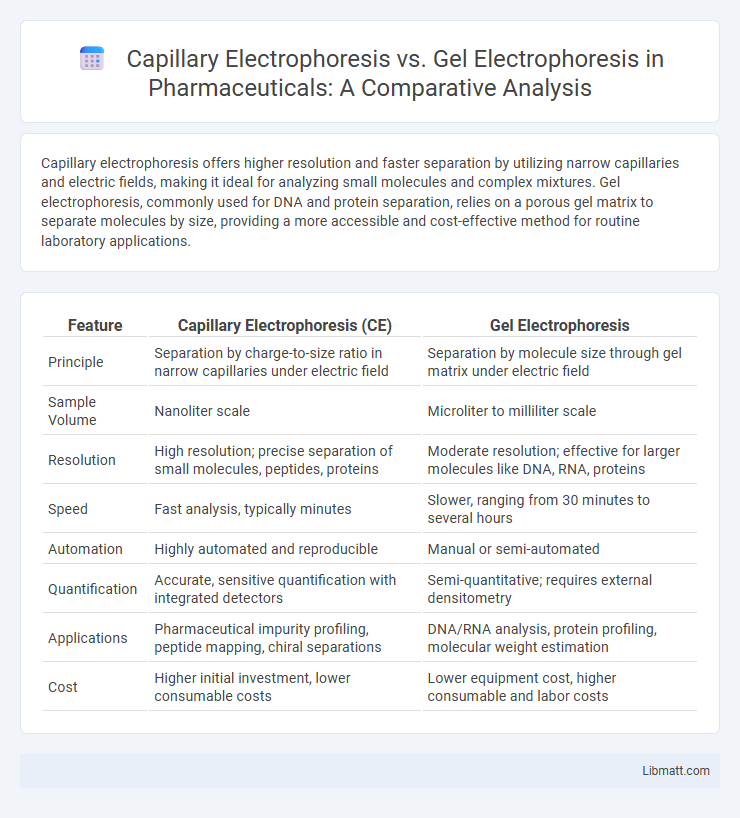Capillary electrophoresis offers higher resolution and faster separation by utilizing narrow capillaries and electric fields, making it ideal for analyzing small molecules and complex mixtures. Gel electrophoresis, commonly used for DNA and protein separation, relies on a porous gel matrix to separate molecules by size, providing a more accessible and cost-effective method for routine laboratory applications.
Table of Comparison
| Feature | Capillary Electrophoresis (CE) | Gel Electrophoresis |
|---|---|---|
| Principle | Separation by charge-to-size ratio in narrow capillaries under electric field | Separation by molecule size through gel matrix under electric field |
| Sample Volume | Nanoliter scale | Microliter to milliliter scale |
| Resolution | High resolution; precise separation of small molecules, peptides, proteins | Moderate resolution; effective for larger molecules like DNA, RNA, proteins |
| Speed | Fast analysis, typically minutes | Slower, ranging from 30 minutes to several hours |
| Automation | Highly automated and reproducible | Manual or semi-automated |
| Quantification | Accurate, sensitive quantification with integrated detectors | Semi-quantitative; requires external densitometry |
| Applications | Pharmaceutical impurity profiling, peptide mapping, chiral separations | DNA/RNA analysis, protein profiling, molecular weight estimation |
| Cost | Higher initial investment, lower consumable costs | Lower equipment cost, higher consumable and labor costs |
Introduction to Electrophoresis Techniques
Capillary electrophoresis (CE) and gel electrophoresis are analytical techniques for separating molecules based on size and charge under an electric field. CE uses narrow capillaries with high-voltage electric fields, offering rapid, high-resolution separation with minimal sample volumes. Gel electrophoresis employs a porous gel matrix, such as agarose or polyacrylamide, providing a cost-effective method for visualizing DNA, RNA, and proteins with moderate resolution and throughput.
Overview of Capillary Electrophoresis
Capillary electrophoresis (CE) is an advanced analytical technique that separates ionic species by their charge and size using narrow capillaries filled with electrolyte solution. Offering high-resolution separation and rapid analysis, CE excels in applications like DNA sequencing, protein characterization, and pharmaceutical quality control. Your choice of CE ensures precise, efficient separation with minimal sample consumption compared to traditional gel electrophoresis.
Fundamentals of Gel Electrophoresis
Gel electrophoresis separates molecules based on size and charge by applying an electric field to a gel matrix, typically agarose or polyacrylamide, which acts as a molecular sieve. DNA, RNA, or proteins migrate through the gel pores at rates inversely proportional to their size, allowing precise size estimation and analysis. Your understanding of the gel's pore size and buffer system is crucial for optimizing resolution and accuracy in molecular separation.
Principle of Separation: Capillary vs Gel
Capillary electrophoresis separates molecules based on their charge-to-size ratio by applying an electric field within a narrow capillary filled with an electrolyte, enabling high-resolution and rapid analysis. Gel electrophoresis relies on a porous gel matrix, such as agarose or polyacrylamide, where molecules migrate through the gel pores under an electric field, with separation primarily influenced by size and shape. Your choice depends on whether you prioritize speed and precision with capillaries or the ability to analyze larger or complex samples with gel matrices.
Sample Preparation and Handling
Capillary electrophoresis requires minimal sample preparation, often involving direct injection of nanoliter volumes, which reduces sample loss and contamination risks. In contrast, gel electrophoresis typically demands extensive sample preparation, including DNA or protein extraction, purification, and loading into wells, increasing handling complexity. Your choice between these methods impacts the ease of sample handling and the potential for sample degradation or variability.
Sensitivity and Detection Methods
Capillary electrophoresis offers higher sensitivity due to its efficient heat dissipation and narrow capillary bore, enabling precise detection of low-concentration analytes using laser-induced fluorescence or amperometric detection. Gel electrophoresis relies on staining methods such as ethidium bromide or Coomassie brilliant blue, which provide moderate sensitivity but lower resolution for detecting small quantities of DNA, RNA, or proteins. The advanced detection systems in capillary electrophoresis result in improved quantitative accuracy and faster analysis compared to traditional gel electrophoresis.
Resolution and Analysis Efficiency
Capillary Electrophoresis (CE) offers superior resolution compared to Gel Electrophoresis due to its use of narrow capillaries and high-voltage electric fields, which allow for more efficient separation of molecules based on size and charge. CE provides faster analysis times and higher throughput, making it ideal for complex sample analysis and quantitative results. Your choice of technique depends on the required resolution and efficiency, with CE being more suitable for precise, rapid separations.
Applications in Research and Industry
Capillary electrophoresis (CE) is extensively used in pharmaceutical analysis for high-resolution separation of small molecules, peptides, and nucleotides, enabling precise quality control and drug development. Gel electrophoresis remains a staple technique in molecular biology for DNA fragment size analysis, protein separation, and genotyping due to its simplicity and cost-effectiveness. Industrial biotechnology leverages CE for rapid chiral separations and impurity profiling, while gel electrophoresis supports routine laboratory workflows in genetic engineering and diagnostic research.
Advantages and Limitations Comparison
Capillary electrophoresis offers higher resolution and faster analysis times compared to gel electrophoresis, making it ideal for precise molecule separation and quantification in complex samples. Gel electrophoresis provides a simpler setup and visual results that are easily interpreted, but it is generally slower and less sensitive for small or low-abundance analytes. Your choice depends on the need for speed and sensitivity versus ease of use and cost-effectiveness in molecular separation techniques.
Future Trends and Technological Developments
Capillary electrophoresis (CE) is advancing with innovations such as microfluidic integration and enhanced laser-induced fluorescence detection, enabling higher sensitivity and rapid analysis, which are key future trends. Gel electrophoresis continues to benefit from developments like automated imaging systems and novel gel materials, improving resolution and throughput for biomolecule separation. Emerging technologies in CE, including chip-based platforms and real-time data analytics, position it as a versatile tool for complex sample analysis, driving its adoption in genomics and proteomics research.
Capillary Electrophoresis vs Gel Electrophoresis Infographic

 libmatt.com
libmatt.com